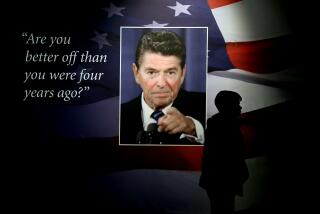A new take on Watergate at Nixon library
- Share via
After decades of being derided as little more than a legacy-and-curio shop designed to burnish Richard Nixon’s image at the expense of the historical record, the Yorba Linda library bearing his name has unveiled a raw and detailed look at the scandal that drove him from office.
The $500,000 Watergate exhibit, four years in the making, features interactive screens, White House tapes and 131 taped interviews that replace the perfunctory, much-ridiculed narrative of Watergate that Nixon himself approved when the library opened with private funds in 1990.
Where the old exhibit featured a heavily edited version of the “smoking gun” tape that sealed Nixon’s resignation in 1974, the new exhibit presents it in full. Where the old text contended that a “mechanical malfunction” explained the infamous 18 1/2-minute gap in a key Nixon conversation, visitors will now be told it was probably a deliberate erasure. And where the old text portrayed the scandal as a “coup” engineered by Nixon’s enemies, the new narrative places the Watergate burglary within a broader pattern of dirty tricks, spying and sabotage by the Nixon White House.
Timothy Naftali, director of the federally run library, said Thursday the exhibit reflected “our self-confidence as a people” and a democracy unafraid of examining “evidence of its own wrongdoing.” At its core, Naftali said, the Watergate story was about “the self-correcting mechanism of our Constitution when one of the branches exceeds its authority.”
The changes did not come without a fight from stalwarts of the 37th president, a seminal figure in postwar California politics whose reputation remains a battleground. Last summer, when the loyalists — some of them former Nixon aides — got a glimpse of how the National Archives-run library planned to portray the Watergate scandal, they responded with a 158-page memo assailing the proposed exhibit line by line, panel by panel.
The Nixon Foundation decried the exhibit, which was originally scheduled to open last July, as being “judgmental,” with a “gross imbalance” and a “lack of context.”
DOCUMENT: Nixon stalwarts’ 158-page critique
The foundation called for the removal of a section titled “Dirty Tricks and Political Espionage” and suggested “something complimentary” be said about Nixon’s top aide, H.R. Haldeman, who served 18 months in prison for covering up the Watergate burglary. Another suggestion: Visitors should be told that warrantless wiretaps and IRS audits of political opponents originated with previous presidents.
The memo, written by foundation president Ronald Walker, a former Nixon aide, complained that the exhibit would be “substantially more negative” in tone than that of the Kennedy, Carter and Reagan libraries in handling controversial aspects of their namesakes’ presidencies.
The foundation’s complaints resulted in a nine-month delay but “no changes of fact and no substantive changes in perspective,” said Naftali, a Harvard-trained historian. He said he did act on the foundation’s contention that visitors should hear more of Nixon’s voice, and included clips of Nixon’s reflections on Watergate during an interview with journalist David Frost.
The “Dirty Tricks” section remained, and Haldeman gets no plaudits. Secret taping occurred in the White House as far back as Franklin Roosevelt’s presidency, the new text explains, yet adds, “This size and scope of President Nixon’s system, however, was unprecedented.”
As the exhibit tells it, the Watergate story really began not with the break-in at the Democratic national headquarters at Washington’s Watergate complex in June 1972 but a year earlier, with Daniel Ellsberg’s leak of a secret government study of the Vietnam War known as the Pentagon Papers. That prompted the Nixon White House to establish a secret group of operatives known as the Plumbers, who burglarized the office of Ellsberg’s psychiatrist to find his file.
One of the exhibit’s interviews features Dwight Chapin, Nixon’s appointments secretary, claiming that Nixon was present when Haldeman ordered the establishment of a dirty-tricks unit for the 1972 presidential campaign. It was Chapin who hired Donald Segretti, a Nixon operative who engaged in the sabotage of Democrats.
“The Nixon Foundation fought tooth and nail to prevent this,” Watergate historian Stanley Kutler said of the exhibit. “The Archives was bending over backward to be accommodating and respectful” to the foundation, he said. “It got to be like a nuisance suit. ‘If not this, then what about that?’ Any fool could see what the end result would be.”
In June 1990, a month before the Richard Nixon Presidential Library and Museum opened, Bob Bostock, who wrote the text of the original exhibit, sent a memo to Nixon seeking his approval of the language.
“My ultimate goal in this exhibit is this: That people will walk away from it, shaking their heads, wondering how the nation ever let such a great president be taken away from them,” he wrote.
Nixon pronounced his plan “brilliant.”
The original exhibit’s characterization of Watergate as a “coup” cemented its reputation as a shrine to Nixon rather than to history. In 2007, as the National Archives assumed control of the library, Naftali set to work redoing the Watergate gallery. His tenure has been a turbulent one. He insisted that docents, who had been conducting tours of the library for years, hew to the historical record. Some, he contended, had not even heard of the Plumbers.
Naftali’s relations with the Nixon Foundation reached a nadir in June 2009, when he invited former White House counsel John Dean to speak on the 37th anniversary of the Watergate break-in. Detested as a traitor by Nixon loyalists, Dean was the first to reveal Nixon’s involvement in the Watergate cover-up.
The foundation responded by temporarily withdrawing event funding, and the controversy became a rallying cry for loyalists.
“It was time to circle the wagons and fight again,” wrote Anne Walker, wife of the foundation chair, in a blog. By her account, the episode helped revive the February Group, a network of Nixon’s former staffers who have grown increasingly close to the foundation in recent years.
John Taylor, a former Nixon aide who directed the foundation until 2009, has emerged as a supporter of Naftali’s work. On Thursday, the men embraced each other warmly, and Naftali described Taylor as a friend.
“If we’re really sure the president over time will be seen as the great president some of us believe he is, we can’t be afraid of what someone might say that’s critical,” Taylor said.
Since his departure from the foundation, Taylor wrote, it has fallen into the hands of “Nixon White House operatives … including individuals involved in Watergate or Watergate-era activities,” and was “enjoying a Haldeman renaissance.”
Joining the foundation board recently was Larry Higby, Haldeman’s aide and later an executive vice president of the Los Angeles Times. After Nixon directed staff to count the Jews working in the Bureau of Labor Statistics, fearing their disloyalty, Higby wrote a memo to Haldeman on July 8, 1971, saying he had determined that White House aide Fred Malek “is not Jewish” himself and therefore fit to perform the count.
And in a Sept. 14, 1971, memo, Dean informed Higby that he was sending “the list of names you requested,” referring to Nixon’s infamous enemies list, which included musician Leonard Bernstein and members of the media.
christopher.goffard@latimes.com
More to Read
Get the L.A. Times Politics newsletter
Deeply reported insights into legislation, politics and policy from Sacramento, Washington and beyond. In your inbox twice per week.
You may occasionally receive promotional content from the Los Angeles Times.











